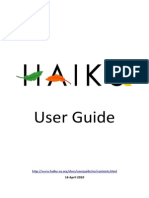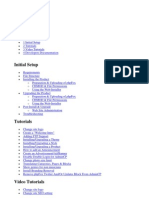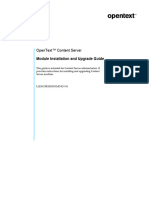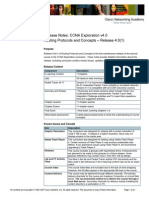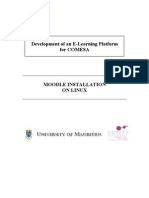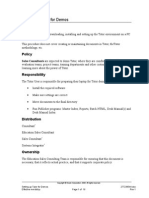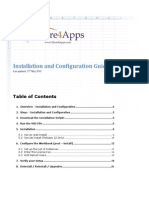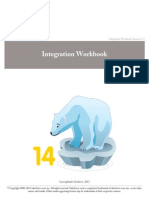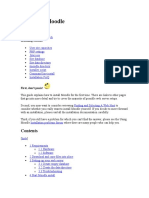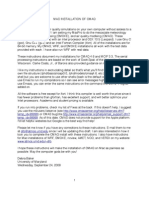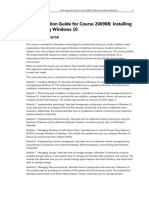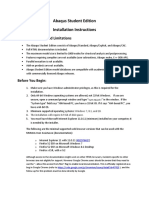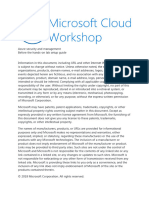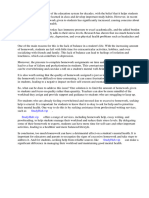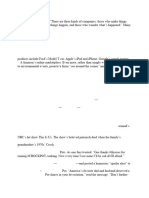Virtual Learning Environment Comparison: Friday, 22 August 2003
Virtual Learning Environment Comparison: Friday, 22 August 2003
Uploaded by
Pradeep Singh ShaktawatCopyright:
Available Formats
Virtual Learning Environment Comparison: Friday, 22 August 2003
Virtual Learning Environment Comparison: Friday, 22 August 2003
Uploaded by
Pradeep Singh ShaktawatOriginal Title
Copyright
Available Formats
Share this document
Did you find this document useful?
Is this content inappropriate?
Copyright:
Available Formats
Virtual Learning Environment Comparison: Friday, 22 August 2003
Virtual Learning Environment Comparison: Friday, 22 August 2003
Uploaded by
Pradeep Singh ShaktawatCopyright:
Available Formats
Friday, 22 August 2003
Virtual Learning Environment Comparison
Contents
Contents ............................................................................................................................................1
Products ............................................................................................................................................1
Installation .........................................................................................................................................2
Moodle ..........................................................................................................................................2
Claroline ........................................................................................................................................2
ATutor ...........................................................................................................................................3
Cost ...................................................................................................................................................3
Features ............................................................................................................................................3
Moodle ..........................................................................................................................................3
Introduction:...............................................................................................................................3
Claroline ........................................................................................................................................4
Introduction................................................................................................................................5
ATutor ...........................................................................................................................................6
Comparison .......................................................................................................................................6
So which one is best? ....................................................................................................................7
Next steps…..............................................................................................................................8
Appendices........................................................................................................................................8
GPL License ..................................................................................................................................8
Products compared
1. Moodle (http://moodle.org/)
2. Claroline (http://www.claroline.net/)
3. ATutor (http://www.atutor.ca/)
All 3 of these Virtual Learning Environment (VLE) systems are written with PHP and MySQL and are
based on the open source (GPL) licence agreement (See appendices). Several other systems have
been investigated during the lifetime of this project, some using different technology including Java
Server Pages, Java Applets, and DHTML. However, it was felt that the infrastructure behind the newly
installed VLE should compliment that of the current Client Management System (CMT) and PTT
Solutions website.
This document will briefly outline the range of facilities that these products offer, comparing the
various advantages of choosing any one system over another. I will then attempt to recommend the
product most suitable for Progress through Training’s current and future needs.
Iain C…
Prepared by Iain Clements Progress through Training 2003 1
Installation
Moodle
Moodle is a VLE developed and written by a PhD student called Martin Dougiamas who was
interested in creating a “
Installing Moodle was relatively simple. It required the source files to be downloaded from the Moodle
website, and then decompressed onto the local hard disk. Once it was successfully saved, the
required files were transferred to the web server and then the settings were changed in the
configuration files to match our settings at Progress through Training. The installation of Moodle was
aided by several automated pages, which speeded up the installation process.
Installation guidelines (taken from the installation package):
Move the Moodle files into your web directory.
Create an empty directory somewhere to store uploaded files (NOT accessible via the web).
This directory must be writeable by the web server process.
Create a single database for Moodle to store all it's tables in (or choose an existing
database).
Copy the file config-dist.php to config.php, and edit it with all your own settings.
Visit your new home page with a web browser. Moodle will lead you through the rest of the
set-up, creating an admin account and so on.
Set up a cron task to call the file admin/cron.php every five minutes or so.
Claroline
Claroline was created by a consortium of French University faculties who were interested in
developing an open-source alternative to Blackboard.
Claroline was relatively easy to install, yet there are added complications in the installation process
due to the fact that the original programming for Claroline was completed in French. Therefore, the
installation processes created several French files and database tables. Additionally, several of the
‘help’ files included with the installation package were also written in French.
Whilst it was not a huge task to translate some of the table names in order to gain understanding of
what data it contained, the author feels that using a product originally developed in a foreign language
could lead to unnecessary time delays in either content authoring or system administration.
Furthermore, PTT’s plan to integrate the Motivational Agent project within the implemented VLE could
be further complicated via this language barrier.
Claroline installation instructions, (taken from the downloaded package)
1. Download 'claroline130.tar.gz' : Windows : download 'claroline130.zip'.
2. Open a shell, go to download directory and type tar -zxvf claroline130.tar.gz : Windows :
unzip 'claroline130.zip'.
3. FTP or move by any means 'index.php' file and 'claroline' directory to your website on
webserver (whether webroot or subdirectory). 'index.php' should remain where it is, outside
'claroline' directory.
Windows: If you use easyphp locally (http://www.easyphp.org), just drag and drop 'index.php'
file and 'claroline' directory into C:\Program Files\easyphp\www\
4. CHMOD 666 claroline/include/config.php if necessary
Prepared by Iain Clements Progress through Training 2003 2
5. Open Web Browser and go to http://www.mydomain.org/mysite/mydir/claroline/install/
6. Windows with easyphp locally, open: http://localhost/claroline/install/ (don't forget the final /).
7. Follow instructions. Windows: if you use easyphp out of the box, login and password for
MySQL should remain empty.
ATutor
ATutor was originally developed as an open-source VLE from Toronto University in Canada, but has
expanded to encompass several Universities across the world.
ATutor was the easiest of the three software systems to install. Once the files had been downloaded,
decompressed and placed in the appropriate file on the web server, it was simply a case of navigating
to the admin screen and running through the installation screens via an Internet browser.
General information
After the required initial installation processes has been completed, it is possible to fully customise the
‘look and feel’ of the various VLEs without making any significant changes to the underlying functional
code. The is achieved via the use of a cascading style sheet (CSS) which allows web designers
complete control of the way that pages are displayed in a browser window. After PTT has been able
to select which VLE it will implement, I will then construct a customised style sheet to match the look
and feel of the PTT Solutions website.
Furthermore, as the ‘code’ required for each of these VLEs is included with the installation package,
more fundamental changes are possible, yet will take more time than constructing a simple Cascading
Style Sheet depending on the complexity of the changes required.
Cost
All three systems discussed in this document are released under the General Public License (GPL),
which means that the initial package can be freely downloaded, installed, and distributed without
charge. However, it is a condition of this agreement that PTT always acknowledges the original
designers of the software, leaving their original copyright messages intact.
All 3 organisations offer commercial services that evolve around the customisation, customer support,
and course design.
Specific ATutor pricing information is available at: http://www.atutor.ca/services/pricing.php
Features
Moodle
Introduction:
(Taken from the Moodle.org website)
Moodle is a software package for producing internet-based courses and web sites. It is an ongoing
development project designed to support a social constructionist framework of education.
Moodle is provided freely as Open Source software (under the GNU Public License). Basically this
means Moodle is copyrighted, but that you have additional freedoms. You are allowed to copy, use
and modify Moodle provided that you agree: to provide the source to others; to not modify or remove
Prepared by Iain Clements Progress through Training 2003 3
the original license, and apply this same license to any derivative work. Read the license for full
details and please contact the copyright holder directly if you have any questions.
Moodle will run on any computer that can run PHP, and can support many types of database
(particularly MySQL).
The word Moodle was originally an acronym for Modular Object-Oriented Dynamic Learning
Environment, which is mostly useful to programmers and education theorists. It's also a verb that
describes the process of lazily meandering through something, doing things as it occurs to you to do
them, an enjoyable tinkering that often leads to insight and creativity. As such it applies both to the
way Moodle was developed, and to the way a student or teacher might approach studying or teaching
an online course.
Features included within Moodle:
Layout of the site can be fully customised for particular courses
Themed discussion forum
Ability for the course planners to set weekly announcements in advance
o Users are reminded of forthcoming announcements/assignments when they first log
into the system
Ability for trainers to set students any number of assignments, with targeted completion dates
Moodle tracks assignments completed and grades allocated by trainers
o However, this information has to be manually entered – the system does not mark, or
allocate grades automatically
Option to create a variety of surveys in order to spark discussion amongst learners
Basic security features to limit customer access to particular courses
o Therefore, PTT could introduce a charge for accessing the system without any major
alterations to the code
Moodle allows users to upload their own learning material to the site to share with other users
o This feature could be useful in creating an ‘organic learning environment’ where the
amount of learning material available on the system grows without administrator
intervention
o However, there could be several copyright implications associated with the type of
material that users would upload, so regular monitoring would be required by PTT
administration
‘Journal feature’ to allow students to post questions, maintain a course diary, or aid revision
Theme feature to allow administrators/students to change the look & feel of the VLE without
requiring a new style sheet
Claroline
Prepared by Iain Clements Progress through Training 2003 4
Introduction
(Taken from the installation documentation included with the package)
Claroline is GPL software working with PHP/MySQL. It is a course based educational tool allowing the
professor to create, admin and feed his courses through the web. If you would like to help develop
this software, please visit our homepage at http://www.claroline.net. Claroline is distributed under the
Gnu General Public license (GPL). See claroline/license/gpl_print.txt
Features included within Claroline:
Different approach to other VLEs, courses are broken down into component elements, and
then published on the site under separate areas (announcements, exercises, chats,
resources, links etc)
Students have full flexibility in the order that they undertake the elements of the course,
whether they are exercises, required reading, discussions, or similar
Categorised links feature for both students and course administrators to manage relevant
URLs
Agenda feature include which allows authors to set announcements & deadlines for all course
members to see
Offers fully optional layout for course beneficiaries
o Administrators can control which ‘course elements’ are displayed via a simple
interface screen
Chat facility for all users
o However, it is a very simple text interface system
Claroline allows students to upload their own papers to the system for peer review
o As mentioned in the write up for Moodle, this feature could be useful in an attempt to
create a system that is developed & sustained by both administrators and fellow
students
Option for the system to process registration automatically, or for manual administration.
o (Self-registration would most likely be deactivated on a revenue generating system).
Courses can start with a limited number of resources, but grow in size and complexity
o Administrators can add them gradually as course users require them
Statistics function for course administrators to monitor number of courses, course popularity
etc.
o Therefore, it will allow PTT to analyse which courses are the most popular
Ability for course administrators to set exercises and assign completion deadlines
Ability to upload video files for use as course resources
o N.B this is the only system with a specific video-handling feature, but others could be
adapted to allow for the use of this media in courses
Prepared by Iain Clements Progress through Training 2003 5
ATutor
Features included within ATutor:
Theme feature allows administrators to change the look of the VLE, without requiring the
creation of a new style sheet
Very straightforward course administrator interface
o Course construction broken down into designing a series of ‘content pages’
Export feature for courses created within the system
o Although the export format is not SCORM/IMS standards compliant, this feature
would be useful for transporting content between systems and administering backups
o N.B. This is the only system mentioned that has this feature
Features integrated ‘inbox’ for inter-course communication from both course administrators
and other users
‘Send course e-mail’ feature to allow all course students to be contacted simultaneously
Course structure is built on a ‘slide by slide’ basis
o Very simple to author and navigate, but would require rudimentary HTML skills on the
author’s part
Context sensitive help feature, which allows course administrators to highlight particular
sections of text and allow users to access additional help
Inbuilt glossary function to users with particular terms & acronyms
Links to various other educational database are included with the download package
Excellent documentation & help manuals to aid users in course navigation
Wide range of developers working on current project – wide support base for future versions
of ATutor
ATutor website states that they are currently working towards conformance with present and
future e-learning standards
o Therefore, future editions of ATutor may integrate with other ‘standard’ systems
Dynamic site mapping feature that grows as more courses are authored on the system
Flexible assignment creator tool
Print compiler tool – allows students to select various pages of text and group them together
on one page
Integrate WYSIWYG editor for creating course content without the need for HTML knowledge
Comparison
As can be seen from the features list made above for each of the three systems there are various
benefits/disadvantages incurred when selecting any one VLE over another. None of the systems
Prepared by Iain Clements Progress through Training 2003 6
examined in this report are fully compatible with the current Shareable Content Object Reference
Model (SCORM) standards for sharing/distributing content between different VLEs.
Additionally, none of the systems mentioned today use XML metadata to describe e-learning content
within the systems. However, it is worth mentioning that the current development team for the ATutor
product have expressed a clear interest to achieve standards compliance within future versions of the
software.
Yet, without the encumbering technical elements of the SCORM the
authoring process for new courses (which would be completed by
consultants within Progress through Training), is much simplified. Creating
a new course can be as simple as designing several different ‘pages’
(Moodle, ATutor) of content (which could easily be transferred from current
PTT material), and then organising them so that they flow in a logical
manner.
In addition to these ‘course slides’ consultants can then assign specific resources to accompany each
slide. In Moodle and ATutor there would not be a requirement for HTML knowledge when authoring
content, (a clear benefit for PTT staff in reduced development time).
The collaborative features included in the learning environments
vary in both complexity and usability. ATutor is the only system to
feature an internal ‘e-mail’ system to allow course users to
intercommunicate. I believe that this is a very useful feature to
have within a VLE, as it promotes collaboration/networking
between users. Additionally, each system requires a valid e-mail
address to be collected from each user so communication via
external e-mail systems would be entirely possible.
On an authoring note, I personally found that Moodle’s interface for
creating course content was the most intuitive, and featured a very
simple to use What You See Is What You Get (WYSIWYG) editor.
The use of this editor would remove the need for the consultants
within PTT to learn any Internet display languages such as Hyper
Text Mark-Up Language (HTML), which would significantly reduce the
development time required to start creating course content.
So which one is best?
The final conclusion of this report calls for a nomination for the most suitable VLE for Progress
through Training’s needs. It is this author’s recommendation that ATutor be selected as the VLE to
implement within the company. Out of all three systems, I feel that ATutor has the best blend of
sophistication, usability, and range of similar features to those found on commercial VLE systems.
On an administrative note, ATutor was very easy to install, configure and run. The layout of the control
panel was very intuitive, and the additional help provided by the demonstration course was very
useful before I created my first test course within the system. Out of all three systems, ATutor easily
featured the most tools.
I believe that the ‘print compiler’ will be particularly useful for course delegates who wish to keep a
copy of their notes as they progress through their course. Furthermore, the fact that the development
team behind ATutor are committed to achieving standards compliance in future versions should mean
PTT can work towards conformance at a similar pace to the development of the software.
As mentioned in previous sections, ATutor comes complete with its own editor window for creating
course content, notes and announcements. Furthermore, it offers the designer flexibility in deciding
whether they will enter information in plain text, or attempt to code their own HTML.
Prepared by Iain Clements Progress through Training 2003 7
Next steps…
It is recommended that each of these systems be demonstrated prior to the company making a final
decision. Therefore, it is suggested that a suitable time be arranged at the earliest convenience in the
near future to allow for this demonstration to take place.
Furthermore, it is suggested that research into open-source Virtual Learning Environments is ongoing
at PTT. This should ensure that future VLE developments are analysed and their benefits to the
company discussed and implemented.
Appendices
GPL License
GNU GENERAL PUBLIC LICENSE
Version 2, June 1991
Copyright (C) 1989, 1991 Free Software Foundation, Inc.
59 Temple Place, Suite 330, Boston, MA 02111-1307 USA
Everyone is permitted to copy and distribute verbatim copies of this license document, but changing it
is not allowed.
Preamble
The licenses for most software are designed to take away your freedom to share and change it. By
contrast, the GNU General Public license is intended to guarantee your freedom to share and change
free software--to make sure the software is free for all its users. This
General Public License applies to most of the Free Software Foundation's software and to any other
program whose authors commit to using it. (Some other Free Software Foundation software is
covered by the GNU Library General Public License instead.) You can apply it to your programs, too.
When we speak of free software, we are referring to freedom, not price. Our General Public Licenses
are designed to make sure that you have the freedom to distribute copies of free software (and
charge for this service if you wish), that you receive source code or can get it if you want it, that you
can change the software or use pieces of it in new free programs; and that you know you can do
these things.
To protect your rights, we need to make restrictions that forbid anyone to deny you these rights or to
ask you to surrender the rights. These restrictions translate to certain responsibilities for you if you
distribute copies of the software, or if you modify it.
For example, if you distribute copies of such a program, whether gratis or for a fee, you must give the
recipients all the rights that you have. You must make sure that they, too, receive or can get the
source code. And you must show them these terms so they know their rights.
We protect your rights with two steps: (1) copyright the software, and (2) offer you this license which
gives you legal permission to copy, distribute and/or modify the software.
Also, for each author's protection and ours, we want to make certain that everyone understands that
there is no warranty for this free software. If the software is modified by someone else and passed
on, we want its recipients to know that what they have is not the original, so that any problems
introduced by others will not reflect on the original authors' reputations.
Finally, any free program is threatened constantly by software patents. We wish to avoid the danger
that redistributors of a free program will individually obtain patent licenses, in effect making the
Prepared by Iain Clements Progress through Training 2003 8
program proprietary. To prevent this, we have made it clear that any patent must be licensed for
everyone's free use or not licensed at all.
The precise terms and conditions for copying, distribution and modification follow.
GNU GENERAL PUBLIC LICENSE TERMS AND CONDITIONS FOR COPYING, DISTRIBUTION
AND MODIFICATION
0. This License applies to any program or other work which contains a notice placed by the copyright
holder saying it may be distributed under the terms of this General Public License. The "Program",
below, refers to any such program or work, and a "work based on the Program" means either the
Program or any derivative work under copyright law: that is to say, a work containing the Program or a
portion of it, either verbatim or with modifications and/or translated into another language.
(Hereinafter, translation is included without limitation in the term "modification".) Each licensee is
addressed as "you".
Activities other than copying, distribution and modification are not covered by this License; they are
outside its scope. The act of running the Program is not restricted, and the output from the Program
is covered only if its contents constitute a work based on the Program (independent of having been
made by running the Program).
Whether that is true depends on what the Program does.
1. You may copy and distribute verbatim copies of the Program's source code as you receive it, in any
medium, provided that you conspicuously and appropriately publish on each copy an appropriate
copyright notice and disclaimer of warranty; keep intact all the notices that refer to this License and to
the absence of any warranty; and give any other recipients of the Program a copy of this License
along with the Program.
You may charge a fee for the physical act of transferring a copy, and you may at your option offer
warranty protection in exchange for a fee.
2. You may modify your copy or copies of the Program or any portion of it, thus forming a work based
on the Program, and copy and distribute such modifications or work under the terms of Section 1
above, provided that you also meet all of these conditions:
a) You must cause the modified files to carry prominent notices stating that you changed the files
and the date of any change.
b) You must cause any work that you distribute or publish, that in whole or in part contains or is
derived from the Program or any part thereof, to be licensed as a whole at no charge to all third
parties under the terms of this License.
c) If the modified program normally reads commands interactively when run, you must cause it,
when started running for such interactive use in the most ordinary way, to print or display an
announcement including an appropriate copyright notice and a notice that there is no warranty (or
else, saying that you provide a warranty) and that users may redistribute the program under
these conditions, and telling the user how to view a copy of this License. (Exception: if the
Program itself is interactive but does not normally print such an announcement, your work based on
the Program is not required to print an announcement.)
These requirements apply to the modified work as a whole. If identifiable sections of that work are not
derived from the Program, and can be reasonably considered independent and separate works in
themselves, then this License, and its terms, do not apply to those sections when you distribute them
as separate works. But when you distribute the same sections as part of a whole which is a work
based on the Program, the distribution of the whole must be on the terms of this License, whose
permissions for other licensees extend to the entire whole, and thus to each and every part regardless
of who wrote it.
Thus, it is not the intent of this section to claim rights or contest your rights to work written entirely by
you; rather, the intent is to exercise the right to control the distribution of derivative or
Prepared by Iain Clements Progress through Training 2003 9
collective works based on the Program. In addition, mere aggregation of another work not based on
the Program with the Program (or with a work based on the Program) on a volume of
a storage or distribution medium does not bring the other work under the scope of this License.
3. You may copy and distribute the Program (or a work based on it, under Section 2) in object code or
executable form under the terms of Sections 1 and 2 above provided that you also do one of the
following:
a) Accompany it with the complete corresponding machine-readable source code, which must be
distributed under the terms of Sections 1 and 2 above on a medium customarily used for software
interchange; or,
b) Accompany it with a written offer, valid for at least three years, to give any third party, for a
charge no more than your cost of physically performing source distribution, a complete machine-
readable copy of the corresponding source code, to be distributed under the terms of Sections 1 and
2 above on a medium customarily used for software interchange; or,
c) Accompany it with the information you received as to the offer to distribute corresponding source
code. (This alternative is allowed only for non-commercial distribution and only if you received the
program in object code or executable form with such an offer, in accord with Subsection b above.)
The source code for a work means the preferred form of the work for making modifications to it. For
an executable work, complete source code means all the source code for all modules it contains, plus
any associated interface definition files, plus the scripts used to control compilation and installation of
the executable. However, as a special exception, the source code distributed need not include
anything that is normally distributed (in either source or binary form) with the major components
(compiler, kernel, and so on) of the operating system on which the executable runs, unless that
component itself accompanies the executable.
If distribution of executable or object code is made by offering access to copy from a designated
place, then offering equivalent access to copy the source code from the same place counts as
distribution of the source code, even though third parties are not compelled to copy the source along
with the object code.
4. You may not copy, modify, sublicense, or distribute the Program except as expressly provided
under this License. Any attempt otherwise to copy, modify, sublicense or distribute the Program is
void, and will automatically terminate your rights under this License. However, parties who have
received copies, or rights, from you under this License will not have their licenses terminated so long
as such parties remain in full compliance.
5. You are not required to accept this License, since you have not signed it. However, nothing else
grants you permission to modify or distribute the Program or its derivative works. These actions are
prohibited by law if you do not accept this License. Therefore, by modifying or distributing the
Program (or any work based on the Program), you indicate your acceptance of this License to do so,
and all its terms and conditions for copying, distributing or modifying the Program or works based on
it.
6. Each time you redistribute the Program (or any work based on the Program), the recipient
automatically receives a license from the original licensor to copy, distribute or modify the Program
subject to these terms and conditions. You may not impose any further restrictions on the recipients'
exercise of the rights granted herein. You are not responsible for enforcing compliance by third parties
to this License.
7. If, as a consequence of a court judgment or allegation of patent infringement or for any other
reason (not limited to patent issues), conditions are imposed on you (whether by court order,
agreement or otherwise) that contradict the conditions of this License, they do not excuse you from
the conditions of this License. If you cannot distribute so as to satisfy simultaneously your obligations
under this License and any other pertinent obligations, then as a consequence you
may not distribute the Program at all. For example, if a patent license would not permit royalty-free
redistribution of the Program by all those who receive copies directly or indirectly through you, then
Prepared by Iain Clements Progress through Training 2003 10
the only way you could satisfy both it and this License would be to refrain entirely from distribution of
the Program.
If any portion of this section is held invalid or unenforceable under any particular circumstance, the
balance of the section is intended to apply and the section as a whole is intended to apply in other
circumstances.
It is not the purpose of this section to induce you to infringe any patents or other property right claims
or to contest validity of any such claims; this section has the sole purpose of protecting the
integrity of the free software distribution system, which is implemented by public license practices.
Many people have made generous contributions to the wide range of software distributed
through that system in reliance on consistent application of that system; it is up to the author/donor to
decide if he or she is willing to distribute software through any other system and a licensee cannot
impose that choice.
This section is intended to make thoroughly clear what is believed to be a consequence of the rest of
this License.
8. If the distribution and/or use of the Program is restricted in certain countries either by patents or by
copyrighted interfaces, the original copyright holder who places the Program under this License
may add an explicit geographical distribution limitation excluding those countries, so that distribution
is permitted only in or among countries not thus excluded. In such case, this License incorporates
the limitation as if written in the body of this License.
9. The Free Software Foundation may publish revised and/or new versions of the General Public
License from time to time. Such new versions will be similar in spirit to the present version, but may
differ in detail to address new problems or concerns.
Each version is given a distinguishing version number. If the Program specifies a version number of
this License which applies to it and "any later version", you have the option of following the terms and
conditions either of that version or of any later version published by the Free Software Foundation. If
the Program does not specify a version number of this License, you may choose any version ever
published by the Free Software Foundation.
10. If you wish to incorporate parts of the Program into other free programs whose distribution
conditions are different, write to the author to ask for permission. For software which is copyrighted
by the Free Software Foundation, write to the Free Software Foundation; we sometimes
make exceptions for this. Our decision will be guided by the two goals of preserving the free status of
all derivatives of our free software and of promoting the sharing and reuse of software generally.
NO WARRANTY
11. Because the program is licensed free of charge, there is no warranty For the program, to the
extent permitted by applicable law. Except when Otherwise stated in writing the copyright holders
and/or other parties Provide the program "as is" without warranty of any kind, either expressed
Or implied, including, but not limited to, the implied warranties of Merchantability and fitness for a
particular purpose. The entire risk as To the quality and performance of the program is with you.
Should the Program prove defective, you assume the cost of all necessary servicing, Repair or
correction.
12. In no event unless required by applicable law or agreed to in writing Will any copyright holder, or
any other party who may modify and/or Redistribute the program as permitted above, be liable to you
for damages, Including any general, special, incidental or consequential damages arising
Out of the use or inability to use the program (including but not limited To loss of data or data being
rendered inaccurate or losses sustained by You or third parties or a failure of the program to operate
with any other Programs), even if such holder or other party has been advised of the Possibility of
such damages.
End of terms and conditions
Prepared by Iain Clements Progress through Training 2003 11
You might also like
- ndToolKit User Guide - July 2021Document32 pagesndToolKit User Guide - July 2021Carlos VillarrealNo ratings yet
- TS 02025 - 1.00 - Testing of Cast-in-Place Concrete PilesDocument13 pagesTS 02025 - 1.00 - Testing of Cast-in-Place Concrete PilespabulumzengNo ratings yet
- NSCOA LabGuide v24.02Document81 pagesNSCOA LabGuide v24.02Jorge CalderonNo ratings yet
- Dutch East India Company Merchants at The Court of Ayutthaya PDFDocument297 pagesDutch East India Company Merchants at The Court of Ayutthaya PDFSherry Kwok100% (1)
- Planning Grid Junior Cert 1st Year Wood TechnologyDocument6 pagesPlanning Grid Junior Cert 1st Year Wood Technologyapi-543529812No ratings yet
- Code-It Project ReportDocument40 pagesCode-It Project Reportm r100% (1)
- Haiku User Guide PDFDocument112 pagesHaiku User Guide PDFΘΑΝΑΣΗΣ ΒΑΚΟΥΦΤΣΗΣNo ratings yet
- EyOS Installation Manual WindowsDocument36 pagesEyOS Installation Manual WindowsnebondzaNo ratings yet
- wIN seRVER 2012 Test Lab GuideDocument36 pageswIN seRVER 2012 Test Lab Guideasesora educacionNo ratings yet
- Installing Moodle - MoodleDocsDocument10 pagesInstalling Moodle - MoodleDocsMNo ratings yet
- MyPleo Installation and DeploymentDocument17 pagesMyPleo Installation and DeploymentVioNo ratings yet
- EyeOS Installation Manual Linux V1.0Document35 pagesEyeOS Installation Manual Linux V1.0Manoj KhadilkarNo ratings yet
- Installing Moodle - Moodle DocsDocument8 pagesInstalling Moodle - Moodle DocsSan Salvador CarlosNo ratings yet
- OpenText Content Server CE 21.3 - Module Installation and Upgrade Guide English (LLESCOR210300-IMO-En-01)Document22 pagesOpenText Content Server CE 21.3 - Module Installation and Upgrade Guide English (LLESCOR210300-IMO-En-01)nippanisasiNo ratings yet
- Guida2 0Document82 pagesGuida2 0Leon IngiroNo ratings yet
- Mule Esb 3 TutorialDocument20 pagesMule Esb 3 TutorialAshutosh MishraNo ratings yet
- OpenText Content Server 20.2.0 - Module Installation and Upgrade Guide English (LLESCOR200200-IMO-EN-01)Document22 pagesOpenText Content Server 20.2.0 - Module Installation and Upgrade Guide English (LLESCOR200200-IMO-EN-01)Jithesh KtNo ratings yet
- ReleaseNotes ERouting v4 0 1Document21 pagesReleaseNotes ERouting v4 0 1devilishaloNo ratings yet
- Module 9: Installing Backward-Compatible Document LibrariesDocument14 pagesModule 9: Installing Backward-Compatible Document LibrariesJosé MarquesNo ratings yet
- Installation Quick Guide - MoodleDocsDocument4 pagesInstallation Quick Guide - MoodleDocssiliaskoNo ratings yet
- Release Notes CCNA ENetwork v4 0Document5 pagesRelease Notes CCNA ENetwork v4 0Lieliel WardaniNo ratings yet
- 3.moodle Installation LinuxDocument15 pages3.moodle Installation LinuxSandhya GunnessNo ratings yet
- Installation Quick Guide - MoodleDocsDocument2 pagesInstallation Quick Guide - MoodleDocssahabat keluargaNo ratings yet
- Assessment 3Document17 pagesAssessment 3Durga prasad TNo ratings yet
- Setting Up Tutor For Demos: ScopeDocument16 pagesSetting Up Tutor For Demos: ScopecanjiatpNo ratings yet
- Department of Veterans Affairs Open Source Electronic Health Record ServicesDocument18 pagesDepartment of Veterans Affairs Open Source Electronic Health Record ServicesjjomierNo ratings yet
- Automated Deployment WhitepaperDocument20 pagesAutomated Deployment WhitepaperadiclNo ratings yet
- Technical GuideDocument9 pagesTechnical Guidehimubhau21No ratings yet
- Toadxpert Installation: Development Workbench - OracleDocument7 pagesToadxpert Installation: Development Workbench - Oraclevinai.20No ratings yet
- Kitchen DrawDocument62 pagesKitchen DrawdrazenNo ratings yet
- Installation and Config GuideDocument21 pagesInstallation and Config Guidehabibi722847No ratings yet
- Docebo GuideDocument127 pagesDocebo Guidepulak047No ratings yet
- Integration WorkbookDocument20 pagesIntegration WorkbookShekhar GadewarNo ratings yet
- Open Administration For Schools 4.75: Administrator Documentation Les Richardson July, 2010Document52 pagesOpen Administration For Schools 4.75: Administrator Documentation Les Richardson July, 2010Peter SimendiNo ratings yet
- Installing Moodle: From MoodledocsDocument27 pagesInstalling Moodle: From Moodledocsvsc21No ratings yet
- Continuous Integration and Deployment With Rancher and DockerDocument47 pagesContinuous Integration and Deployment With Rancher and DockerNeenu AnandNo ratings yet
- Internet Explorer Internet Explorer 5 5Document520 pagesInternet Explorer Internet Explorer 5 5Rengga Virgian Panca WardanaNo ratings yet
- CMAQDocument28 pagesCMAQjohnn_envNo ratings yet
- 20698B TrainerPrepGuideDocument8 pages20698B TrainerPrepGuideErdem EnustNo ratings yet
- Projectpier ManualDocument13 pagesProjectpier ManualVimal RishiNo ratings yet
- Oracle VM PDFDocument29 pagesOracle VM PDFamrbooksNo ratings yet
- Memoq: Getting Started GuideDocument38 pagesMemoq: Getting Started GuideZhu Li'anNo ratings yet
- Dokeos: The Dokeos 1.8.2 Installation ManualDocument29 pagesDokeos: The Dokeos 1.8.2 Installation ManualFaress BacharNo ratings yet
- SoftWareProcess_L4Document26 pagesSoftWareProcess_L4raniaalfikyNo ratings yet
- How To Create A Product ...Document4 pagesHow To Create A Product ...Khairul IzhamNo ratings yet
- Main Page Installation Installing MoodleDocument14 pagesMain Page Installation Installing MoodleAcostaSilveraNo ratings yet
- PTS ODI11g Workshop LabBook Nov-2010Document266 pagesPTS ODI11g Workshop LabBook Nov-2010davidmm81No ratings yet
- Development MoodleDocument145 pagesDevelopment MoodleAdry CallejaNo ratings yet
- Abaqus SE 2018 InstallationGuideDocument14 pagesAbaqus SE 2018 InstallationGuideAnonymous I8nZsDqlmhNo ratings yet
- Course_Setup_for_Petrel_Well_Correlation_Training_using_Studio_DatabaseDocument33 pagesCourse_Setup_for_Petrel_Well_Correlation_Training_using_Studio_DatabaseAlejandro GonzálezNo ratings yet
- Pro - ENGINEER Customization - Missing ManualsDocument11 pagesPro - ENGINEER Customization - Missing ManualsSaras ChandraNo ratings yet
- Getting Started 3.5Document14 pagesGetting Started 3.5Rohini EdkeNo ratings yet
- Deployment With Docker and Rancher and Continuous Integration andDocument47 pagesDeployment With Docker and Rancher and Continuous Integration andManish MalhotraNo ratings yet
- Creating ModulesDocument26 pagesCreating ModulesBolot KalilNo ratings yet
- CSCE 120: Learning To Code: Hacktivity 1.1: Getting StartedDocument5 pagesCSCE 120: Learning To Code: Hacktivity 1.1: Getting Starteds_gamal15No ratings yet
- Option Lab - User's GuideDocument39 pagesOption Lab - User's GuidealexgriosNo ratings yet
- ASM - Before HOLDocument13 pagesASM - Before HOLhari haranNo ratings yet
- Kubernetes: Build and Deploy Modern Applications in a Scalable Infrastructure. The Complete Guide to the Most Modern Scalable Software Infrastructure.: Docker & Kubernetes, #2From EverandKubernetes: Build and Deploy Modern Applications in a Scalable Infrastructure. The Complete Guide to the Most Modern Scalable Software Infrastructure.: Docker & Kubernetes, #2No ratings yet
- Drupal 8 Blueprints: Step along the creation of 7 professional-grade Drupal sitesFrom EverandDrupal 8 Blueprints: Step along the creation of 7 professional-grade Drupal sitesNo ratings yet
- Beginning Jakarta EE: Enterprise Edition for Java: From Novice to ProfessionalFrom EverandBeginning Jakarta EE: Enterprise Edition for Java: From Novice to ProfessionalNo ratings yet
- Docker Tutorial for Beginners: Learn Programming, Containers, Data Structures, Software Engineering, and CodingFrom EverandDocker Tutorial for Beginners: Learn Programming, Containers, Data Structures, Software Engineering, and CodingRating: 5 out of 5 stars5/5 (1)
- Academic Calendar Enen 2023 2024Document3 pagesAcademic Calendar Enen 2023 2024Yousef AbuhejlehNo ratings yet
- Limba EnglezaDocument61 pagesLimba Englezapluci09No ratings yet
- Ecd 102 Developmental Domain Theory To Practice 2013Document4 pagesEcd 102 Developmental Domain Theory To Practice 2013api-311188245No ratings yet
- Toy Biz 24 Exhibition Call for ApplicationDocument1 pageToy Biz 24 Exhibition Call for Applicationveera.deva.0110No ratings yet
- DC024 PracticalDocument12 pagesDC024 PracticalazmiahNo ratings yet
- GRC 2018 Mastre RedesignyoursapeccsecurityDocument40 pagesGRC 2018 Mastre RedesignyoursapeccsecurityPau TorregrosaNo ratings yet
- Esparza v. State of Utah, 10th Cir. (2007)Document5 pagesEsparza v. State of Utah, 10th Cir. (2007)Scribd Government DocsNo ratings yet
- UCAS Co Ordinator Applicant Information PackDocument8 pagesUCAS Co Ordinator Applicant Information PackJames BennettNo ratings yet
- Peachtree Manual 1Document33 pagesPeachtree Manual 1Asaminew DesalegnNo ratings yet
- Valtra Tractor t154v1a7 t194v1a7 t234v1a7 Stage Iiia Service Manual 39296211Document22 pagesValtra Tractor t154v1a7 t194v1a7 t234v1a7 Stage Iiia Service Manual 39296211cleucipleti97No ratings yet
- Too Much Homework Causes DepressionDocument8 pagesToo Much Homework Causes Depressiong3z365gm100% (1)
- 8.financial Statement of Sole Proprietorship and Accounts From Incomplete RecordsDocument7 pages8.financial Statement of Sole Proprietorship and Accounts From Incomplete RecordsReethi SaravananNo ratings yet
- Haffmans CPT: CO Purity TesterDocument2 pagesHaffmans CPT: CO Purity Testermouh niaNo ratings yet
- The Life and Times of HerculesDocument4 pagesThe Life and Times of HerculesterezkiNo ratings yet
- MAteri Kelas 7 - Present TenseDocument3 pagesMAteri Kelas 7 - Present TenseOneKuta febryNo ratings yet
- BTC2 XX W7 Apply R v. Purdy EIC of Joanna HeadDocument7 pagesBTC2 XX W7 Apply R v. Purdy EIC of Joanna HeadchimbelumNo ratings yet
- 3188 Fendt Seat QRG A3 UkDocument10 pages3188 Fendt Seat QRG A3 UkVASILISNo ratings yet
- PackagingDocument6 pagesPackagingJowjie TVNo ratings yet
- Maize Dryer Plant Manufacturers in Hyderabad - Enoch GroupDocument4 pagesMaize Dryer Plant Manufacturers in Hyderabad - Enoch Groupenochsgroup123No ratings yet
- Agri Crop Production 10 q1 DLL Week 1Document7 pagesAgri Crop Production 10 q1 DLL Week 1Joey ceralvoNo ratings yet
- 2Document3 pages2thuvu.31241026051No ratings yet
- Soal Kelas 8 New JawabanDocument3 pagesSoal Kelas 8 New Jawabandaniel7chillgoNo ratings yet
- Fitness Tracker App - Final - CoverDocument48 pagesFitness Tracker App - Final - Coversachin raj Cse d roll 24No ratings yet
- Cambridge University Press, The Classical Association The Classical QuarterlyDocument5 pagesCambridge University Press, The Classical Association The Classical QuarterlySukant MakhijaNo ratings yet
- ELS 28 April 2021Document13 pagesELS 28 April 2021ADMIN SARPRASNo ratings yet
- Take Control of Your PBX: Deploy On Windows, Linux or in The CloudDocument16 pagesTake Control of Your PBX: Deploy On Windows, Linux or in The CloudDON AYUPONo ratings yet
- Dance 3 SyllabusDocument12 pagesDance 3 SyllabusSally MistyNo ratings yet






